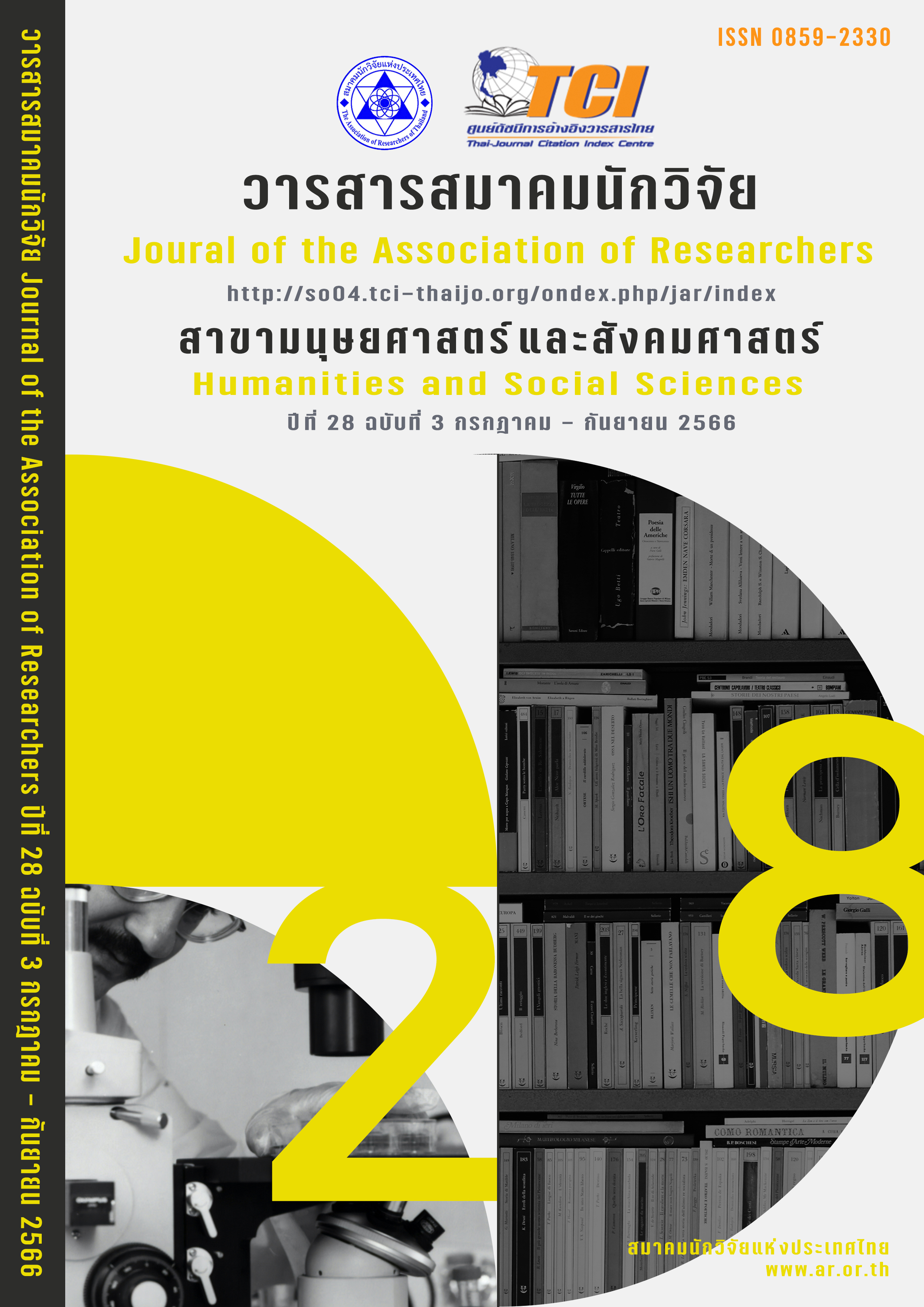Attributes of Cannabis Dispensary Selected by Consumers in Bangkok Metropolitan
Main Article Content
Abstract
This study aimed to 1) examine relationship between demographic factors and consumer behavior pertaining to selection of cannabis dispensary; 2) examine attributes of the cannabis dispensary selected by the consumer; 3) examine the difference between demographic factors and consumer preference of attributes of the cannabis dispensary that was selected by the consumer. The sample group consisted of 400 people living in Bangkok that had or had not used cannabis dispensaries. The sample group size was calculated using Cochran’s formula, and sampling was done using convenience sampling approach. Data collection was collected using a questionnaire on Google Form. Then, the statistics used in data analysis were frequency, percentage, mean, standard deviation, Chi-Square, One-way ANOVA and t-test with statistical significance of 0.05. Most of the sample group were male, aged 31-40 years, single, with a bachelor's degree or equivalent education, working in private companies and average monthly income of 30,001-40,000 baht. The study found that 1) demographic factors such as gender, age, marital status, education level, occupation and average monthly income affected the decision to use the cannabis dispensary service with statistical significance; 2) the sample group selected the cannabis dispensary based on product diversity and convenience as the biggest factors ;3) demographic factors such as age, marital status, education level, occupation and average monthly income affected the Consumer preference of attributes of the cannabis dispensary with statistical significance.
Article Details

This work is licensed under a Creative Commons Attribution-NonCommercial-NoDerivatives 4.0 International License.
บทความที่ปรากฏในวารสารนี้ เป็นความรับผิดชอบของผู้เขียน ซึ่งสมาคมนักวิจัยไม่จำเป็นต้องเห็นด้วยเสมอไป การนำเสนอผลงานวิจัยและบทความในวารสารนี้ไปเผยแพร่สามารถกระทำได้ โดยระบุแหล่งอ้างอิงจาก "วารสารสมาคมนักวิจัย"
References
กรุงเทพธุรกิจ. (2565). ม.หอการค้าไทย เผยธุรกิจกัญชา-กัญชง 3 ปี โต10-15% มูลค่ากว่า 4.2 หมื่นล้านบาท. สืบค้นจาก https://www.bangkokbiznews.com/business/1016632.
ชญาดา มะลินิน และพิพัฒน์ นนทนาธรณ์. (2565). คุณลักษณะของคลินิกกัญชาทางการแพทย์ที่มีผลต่อการเลือกใช้บริการของผู้บริโภคในพื้นที่กรุงเทพมหานคร. วารสารสมาคมนักวิจัย. 27(2), 135-149.
ธัญวลัย บุญมาก และพิพัฒน์ นนทนาธรณ์. (2564). ความรู้ ทัศนคติ และการปฏิบัติต่อการใช้กัญชาของประชากรในเขตภาคกลาง. วารสารสมาคมนักวิจัย. 26(2), 69-85.
นรพรรณ รัตนพิบูลย์ และพิพัฒน์ นนทนาธรณ์. (2565). คุณลักษณะของร้านอาหารที่มีเมนูกัญชาที่ผู้บริโภคเลือกใช้บริการในเขตกรุงเทพมหานคร. วารสารสมาคมนักวิจัย. 27(2), 71-87.
พิพัฒน์ นนทนาธรณ์. (2561). รวมบทความว่าด้วย...ความรับผิดชอบต่อสังคม. กรุงเทพฯ:ศูนย์ผู้นำธุรกิจเพื่อสังคมแห่งมหาวิทยาลัยเกษตรศาสตร์.
ศูนย์วิจัยกสิกรไทย. (2563). “กัญชา” จะกลายเป็นพืชเศรษฐกิจไทย ได้หรือไม่?. สืบค้นจาก https://www.kasikornresearch.com/th/analysis/k-social-media/Pages/FB-Cannabis-14-01-20.aspx.
สถาบันกัญชาทางการแพทย์. (2565). ใช้ กัญชา อย่างเข้าใจ รับ รู้ ปรับใช้ เพื่อสุขภาพที่ดีและปลอดภัย. สืบค้นจาก https://cannabis.fda.moph.go.th/wp-content/uploads/2022/06/manual_use_Cannanbis130665.pdf.
สำนักงานคณะกรรมการป้องกันและปราบปรามยาเสพติด. (2562). องค์ความรู้พืชเสพติด กัญชา. สืบค้นจาก https://www.oncb.go.th/ncsmi/cannabis4/Forms/AllItems.aspx.
Cochran, W. G. (1977). Sampling Techniques. (3rd Ed.). New York: John Wiley & Sons, Inc.
Kotler, P. (2014). Marketing managemen. (14th Ed.). Pearson Education: Prentice Hall.
Kotler, P. & Keller, K. L. (2012). Marketing Management. (14th Ed.). New Jersey: Pearson.
Schiffman, L. G. & Kanuk, L. L. (2007). Consumer behavior: Its origins and strategic Applications. Consumer Behavior. (9th Ed.). New Jersey: Pearson Prentice.
Tybout, A. M. & Calder, B. J. (2010). Kellog on Marketing. (2nd Ed.). New Jersey: John Wiley & Sons, Inc.
Translated Thai References
Bangkokbiznews. (2022). The University of the Thai Chamber of Commerce reveals that the marijuana and hemp industry is expected to grow 10-15% in the next 3 years with a value of over 420 billion baht. Retrieved from https://www.bangkokbiznews.com/business/1016632. (in Thai).
Boonmark, T. & Nonthanathorn, P. (2021). Knowledge, Attitude, and Practice towards Cannabis Use Among People in Central Region. Journal of the Association of Researchers. 26(2), 69-85. (in Thai).
Kasikorn Research Center. (2020). Will "marijuana" become a Thai economic crop?.
Retrieved from https://www.kasikornresearch.com/th/analysis/k-social-media/Pages/FB-Cannabis-14-01-20.aspx. (in Thai).
Malinin, C. & Nonthanathorn, P. (2022). Product Attributes of Medical Cannabis Clinic Affecting to Choice of Service of Consumers in Bangkok Metropolitan. Journal of the Association of Researchers. 27(2), 135-149. (in Thai).
Medical Cannabis Institute. (2022). Use canabis with understanding, awareness, and adaptation for a healthy and safe lifestyle. Retrieved from https://cannabis.fda.moph.go.th/wp-content/uploads/2022/06/manual_use_Cannanbis130665.pdf. (in Thai).
Nonthanathorn, P. (2018). On Social Responsibility. Bangkok: Social Enterprise Leadership Center. (in Thai).
Office of the Narcotics Control Board. (2019). Knowledge of addictive plants, cannabis. Retrieved from https://www.oncb.go.th/ncsmi/cannabis4/Forms/AllItems.aspx. (in Thai).
Rattanapiboon, N. & Nonthanathorn, P. (2022). Product Attributes of Restaurants with Cannabis Menus Selected by Consumers in Bangkok Metropolitan. Journal of the Association of Researchers. 27(2), 71-87. (in Thai).


